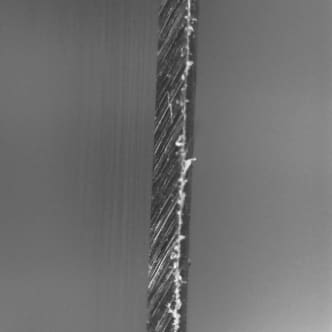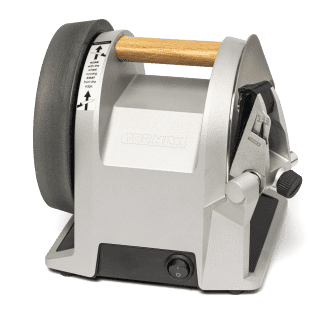For sharpening 15-degree knives, our ATK Recommended favorite is the Chef’sChoice Trizor 15XV, which makes it quick and easy to restore good-as-new cutting edges on blades. (We also named a Best Buy for 15-degree knives, the Chef’sChoice 315XV Knife Sharpener.) For 20-degree knives, we highly recommend the Chef’sChoice Model 130 3-Stage Professional Electric Knife Sharpener, which sharpens 20-degree blades quickly and neatly, with excellent results. If you have a collection of knives with both 15- and 20-degree angles, we recommend the Chef’sChoice Model 1520 Professional Electric Knife Sharpener. And if you have knives with edge angles other than the usual 15 or 20 degrees, our favorite adjustable sharpener, the Tormek T-1 Kitchen Knife Sharpener, can handle blades with edge angles from 8 to 22 degrees.
Prefer to use a manual sharpener? See our review of manual sharpeners. And read our review of honing rods and how to use them for more information on these distinct tools and skills.
The first time you slice into food with a truly sharp knife, it’s eye-opening—you feel like your skills just leveled up. Once you’ve felt the ease and precision of using a sharp knife, you’ll never want to struggle with a dull one again.
Our favorite tool for keeping kitchen knives sharp is an electric knife sharpener. A good one gently brings the dullest, most damaged blade back to life and keeps it in prime shape with quick touch-ups. You don’t need special skills or a lot of time if you have the right electric sharpener, which means that you can take care of your knife in minutes and get back to the real goal: making something delicious to eat.

That said, many (if not most) electric sharpeners we’ve tested over the years are truly terrible—devouring metal, scraping blades, gnawing on handles and chewing up cutting edges. We found that there’s a big difference between the best and worst models.
How Electric Sharpeners Work
Electric sharpeners all operate similarly. You pass the blade of your knife along a rotating disk or belt made from an abrasive material (diamond or ceramic), which removes metal from the blade’s edge.

Many models set the rotating sharpening material inside the body of the machine for your protection and have you pass the knife through one or more V-shaped slots that—to a greater or lesser extent, depending on the sharpener—help control the angle of the blade as it touches the abrasive. (The slots are usually arranged in stages ranging from coarse to fine abrasives.)
Others leave the rotating disk or belt exposed; some of these let you control the angle of your knife manually. (The machine sometimes varies the speed of the rotating abrasive to change the grinding action.) As a final step, many models have slots or separate wheels fitted with leather (or similar synthetic material) that allow you to strop, or polish, your blade, just as barbers do with straight-edge razors. This puts a smooth finish on the blade’s edge.
Should I Get a 15- or 20-Degree Electric Sharpener?
There are several different types of electric knife sharpeners, each used to accommodate blades of one or two different edge angles.
If you look closely at the sharpened edge of a blade, called the bevel, it’s shaped like a “V” or a wedge. In the past, knives from traditional Western manufacturers typically featured broader bevels, with an edge angle of about 20 degrees wide on either side of the point, while Asian manufacturers ground narrower bevels, typically with edge angles of 10 to 15 degrees wide on either side. Those distinctions have eroded in recent years, especially as many Western manufacturers moved toward narrower angles.
We generally prefer knives with edge angles of 15 degrees or smaller, such as our longtime favorite chef’s knife, the Victorinox Swiss Army Fibrox Pro 8" Chef’s Knife. The reason: Knives with smaller edge angles feel sharper. They have thinner, narrower edges that concentrate force so that it’s easier to push through the food. To find out what edge angle your knife has, we recommend checking our reviews or calling the manufacturer.
We know that not everyone has a knife with a 15-degree angle, so we tested knife sharpeners designed to sharpen knives of either 15- or 20-degree angles, or both, or that are adjustable to handle a range of angles. If most of your blades have a 15-degree angle, you should get a 15-degree sharpener; if yours are mostly 20-degree angles, choose a 20-degree sharpener. If you have several knives with different edge angles, seek a model that is adjustable or one that handles multiple angles.
After hours of hands-on sharpening tests, we have recommendations to keep your favorite kitchen knives just the way you want them to be. Regardless of their sharpening angle, certain traits of successful sharpeners emerged.
What to Look For
- Effective Abrasive Material: The sharpening material(s) that comes into contact with and sharpens the blade should be able to fully reshape and polish the knife’s entire cutting edge without damage. We found that diamond abrasives, in a series from coarse to fine, were the most effective.

- Clear Instructions: Models that included clear, detailed instructions made us feel confident that we were sharpening correctly and gave better results.
- A Series of Supportive, V-Shaped Slots: When it’s clear exactly where to apply the knife, with a supportive system to help you hold the blade at the correct angle throughout the sharpening process, you will be able to achieve a better, sharper, and more consistently shaped edge on your knife. Our favorites had enclosed abrasives and narrow, spring-loaded V-shaped slots with no room for ambiguity. Those with a series of separate slots gave us more flexibility, since we could use all of the slots from coarse to fine for fully restoring a very dull knife or only the finer slots for minimal touch-ups.

- Speed: A good model should produce edges as sharp as those of brand-new knives, from heel to tip, in minutes.
- Ability to Repair Damage: Kitchen knives can chip, especially if you misuse them doing risky jobs such as cutting frozen food. A good electric sharpener can repair a chip by grinding the blade past the breakage without damaging the knife. Our top-rated sharpeners completely removed a notch in a chef’s knife in a reasonable amount of time, around 15 to 20 minutes, without leaving the knife further damaged or overly worn down.
- Easy (or No) Assembly: The less you have to set up and adjust before using the sharpener, the more likely you will be to use it. Fewer parts are also easier to keep track of.
- Metal Filing Collection: Sharpening shaves tiny amounts of metal from blades. We prefer models that collect metal filings neatly, often in a magnetic chamber, to those that leave metal filings strewn over our workspace.

Nice to Have
- Quieter Sharpening: While electric knife sharpeners are never going to be silent, we prefer models that make less noise.
What to Avoid
- Overly Abrasive Material: Some machines felt like they grabbed and chewed up our knives. The cutting edges became damaged and unintentionally microserrated instead of smooth and razor sharp. The knives’ heels (and sometimes even their handles) emerged damaged from the coarse abrasive material.


- Ineffective Abrasive Material: It was disappointing to follow instructions correctly, test the knife’s sharpness, and find its blade still dull or unevenly sharpened along the cutting edge. Often, when we went back to sharpen a bit more, results didn’t improve or even worsened. This may be due to a combination of factors, such as the sharpener’s rotational speed or poor blade guides, but our conjecture is that the abrasive material was too finely textured.
- Unclear Instructions: It was frustrating to interpret or have to search the internet for information when using models whose manuals were unclear or incomplete.
- Poor Blade Guides: While all models offered some sort of blade guide to help hold the knife against the sharpening material, those with wider, more nonspecific guides with lots of potential wiggle room tended to sharpen less consistently along the length of blades than models with narrow, guided slots. Poor guides set up a steeper learning curve and put the onus on users to maintain the desired angle.
- Time-Consuming Process: We preferred models that didn’t make us do a lot of preparation, such as attaching and adjusting multiple parts, before and during sharpening. We want to get back to cooking, not spend our time sharpening knives.
- Messy Models: Some sharpeners had poor or no means of collecting the tiny metal shavings, leaving the countertop and the user’s clothing a mess.

The Tests
- Assign new copies of Best Buy 8-inch chef’s knife to each sharpener
- Test edge before and after each sharpening session at tip, center, and heel with industrial sharpness tester and by slicing paper and tomatoes
- Dull knife, then resharpen according to manufacturers’ instructions; repeat
- Drill small notch on blade 3 inches from tip to simulate chipping; use sharpener to repair
- Dull 8-inch carbon-steel chef’s knife and resharpen on each sharpener
- Evaluate condition of knife after sharpening to assess if sharpener damaged any part of it
How We Rated
- Performance: We evaluated the sharpness of the knives after using each sharpener and rated the sharpener’s ability to repair chips on blade edges.
- Ease of Use: We assessed how easy it was to use the sharpeners, following directions and handling the knife as it contacted the sharpener, and considered the overall time required to get good results.
- Cleanup: We evaluated the sharpeners’ ability to contain metal filings and keep the work area clean.
- Damage: We evaluated the condition of knife blades and handles after the sharpening process and whether the sharpeners had caused damage, either functional or cosmetic.



















